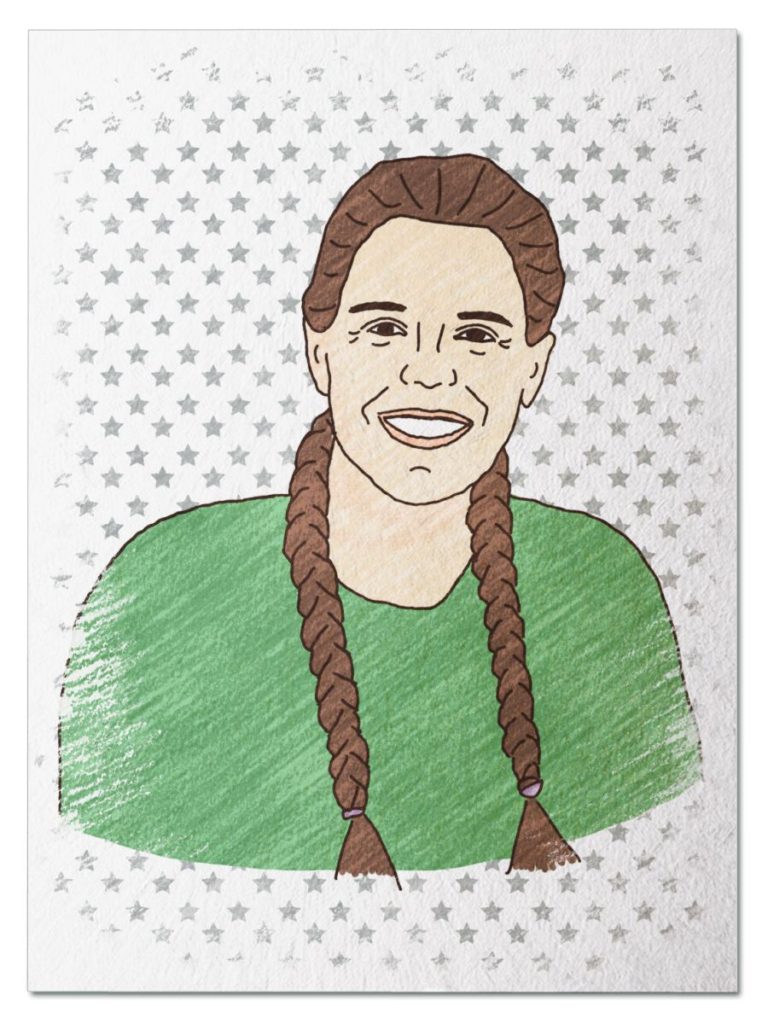
Audacious Adventurer
She was a girl from the Northeast whose childhood love for dogs ended with a journey across the country, first to Colorado and then to Alaska. She learned how to train and care for sled dogs, started her own kennel, and then set a goal of being the best dog sled musher in the world. Step onto a sled during the 1986 Iditarod Trail Dog Sled Race – a 1000 mile trek through the wilds of Alaska – and meet Susan Butcher…
Her Ruby Shoe Moment
The Power of the Wand
Her Yellow Brick Road
Brains, Heart & Courage
Glinda’s Gallery
Just the Facts
Her Ruby Shoe Moment
Susan Butcher pulled into Nome, Alaska. Her face was covered in frost, icicles gathered on her clothing, she couldn’t feel her toes, and she was completely exhausted. But none of that mattered. It was shortly after midnight on March 13, 1986 and she just won the Iditarod Trail Dog Sled Race. On top of it, she set a new speed record — 11 days, 15 hours, and 6 minutes. And the victory was particularly sweet, since she had placed second in the race the past two years.
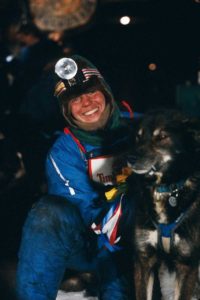
Susan and Granite at Iditarod Finish (trailbreakerkennel.com)
The Iditarod is called the “Last Great Race on Earth” — it is the longest race in the world (and some say its also the toughest race). The course is over 1,000 miles long and runs from Anchorage to Nome, Alaska. The trail was previously used to bring supplies to remote mining towns in the 1800s. And the race itself was inspired by a relay of dog sleds that brought life-saving medicine from a hospital in Anchorage to the residents of Nome in the winter of 1925, in the middle of a diphtheria outbreak. The first Iditarod took place in 1973 and has been held annually ever since.
Susan was ready for the 1986 race. She had trained all year and felt she had one of her best dog teams ever. Luckily for Susan, her lead dog was an Alaskan husky named Granite. Susan and Granite had a special bond, since she had raised him from birth. He was the runt of the litter but she never gave up on him. During training, he worked hard and loved to run. So Susan chose him as lead dog for the 1984 Iditarod and he rose to the challenge.
Susan’s 1986 race wasn’t without mishaps. On the first day, she smashed into a tree and fell off the sled. The dogs kept going and she raced to catch up. Eventually, they stopped and she caught up. She was bruised but all the dogs were okay. Then, Susan and her sled were crossing a frozen creek when one of the dogs fell through the ice. He landed on a second shelf of ice, but couldn’t get back up. And Susan worried the ice would break and plunge them all into the freezing water. So she grabbed her axe and pulled her dog out.
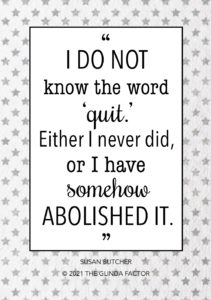 There were over 25 checkpoints along the race trail. At each checkpoint, Susan took care of her dogs and rested for a bit. She massaged their muscles, fed them homemade dog food, made straw beds for them, and rubbed ointment into the pads of their paws. The dogs always came first — if there was time left over, Susan would sneak in a nap. Since she was on the trail about 20 hours per day, Susan could feel herself getting more and more tired as the race went on.
There were over 25 checkpoints along the race trail. At each checkpoint, Susan took care of her dogs and rested for a bit. She massaged their muscles, fed them homemade dog food, made straw beds for them, and rubbed ointment into the pads of their paws. The dogs always came first — if there was time left over, Susan would sneak in a nap. Since she was on the trail about 20 hours per day, Susan could feel herself getting more and more tired as the race went on.
When Susan was within a few miles of Nome, she heard the siren that announced the winner was close. And Granite heard it too. Susan didn’t have to tell him what to do. Granite was determined to win and took off in a sprint. The rest of the dogs followed and began to run faster than ever. Granite didn’t stop until they crossed the finish line and made history.
The Power of the Wand
Susan’s incredible dog sled racing career spanned over 20 years. And she was a trailblazer in more ways than one — she dominated a sport in which men and women competed equally; she brought national attention to the sport of dog sled racing; and she became the only woman to win the Iditarod race more than once. She leveraged her love of dogs into a lifelong career, changing the sport of dog sled racing and making her a champion at the same time.
Sydney Mackey, a 15 year old from Olympia, Washington, has a special relationship with her dog as well. Spitfire, a whippet, is a dock diving world champion. He jumps really far — over 25 feet (longer than most cars). In fact, ESPN has called him “The Michael Jordan of dogs.” Sydney started training with Spitfire when she was 12 years old and he was a natural. They have been training together and breaking world records ever since.
Her Yellow Brick Road
Susan had a big goal — to be the best dog sled musher in the world. She was determined to win the Iditarod Dog Sled Race. And she spent all her time, money, and energy in furtherance of that goal.
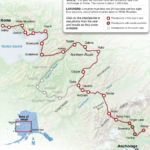
Iditarod Trail Map (Iditarod.com)
Susan worked with her dogs every day. Over time, she learned each dogs’ strength and weaknesses and got to know their personalities. She also looked for characteristics in each of them, such as confidence, strength, intelligence, and the desire to run. And she experimented with different dog placements and pairings, to find the best fit for each of them. She taught them to work as a team, obey her commands, stay on the path, and avoid hazards.
Susan had a strict exercise routine for both herself and her dogs. She needed to build her own strength and endurance for the race, because it was a physically demanding 10 days. She had to control the sled, run alongside the dogs whenever they were tired, and do whatever it took to get herself out of jams. In addition, Susan worked with 4 dog teams per day (she sometimes traveled up to 70 miles per day). She trained each dog team about 3-5 times per week, all year round. When Susan trained in the summer, the dogs pulled Susan on an ATV.
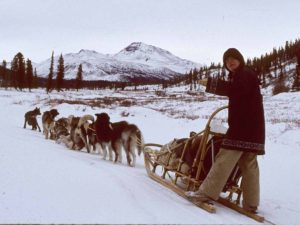
Susan training with her dogs (trailbreakerkennel.com)
Preparations took all year as well. Susan sewed over 1,000 booties, which protected the dog’s from rocks and ice. She made custom-fitted harnesses for each dog. She kept the sled in good condition. She made some of her own winter gear for the race. She made her own dog food. And she packed all her supply bags, which were shipped to each checkpoint along the race.
Susan overcame many obstacles and had a number of close calls over the years. She crashed into trees. She fell down into ravines. She encountered wildlife, including an angry moose. She lost her way in snowstorms and went many miles off course. She fell off the sled and had to chase after it. Her sled tipped and she lost equipment. Her dogs fell through the ice and into freezing water. She almost drowned a few times, but her dogs saved her. Her dogs became injured or sick and she loaded them onto the sled until the next checkpoint.
Susan always learned from her mistakes and came back stronger and more determined the next year. And she never gave up.
Brains, Heart & Courage
Susan developed a love for nature when she was a child — her family spent summers in Brookline, a small town in Maine. And Susan loved it there. She enjoyed being alone in nature. She disliked the city and begged her parents to move to Maine year round. Her parents encouraged Susan to be confident and independent, skills that helped her throughout life.
Susan was four years old when her family got their first dog, a LAB? named Cabee. She relied on Cabee during the tough times, especially when her parents divorced when she was 11 years old. Cabee became her best friend. Susan loved being surrounded by lots of dogs — when she took Cabee for a walk, she gathered the others dogs in the neighborhood as well.
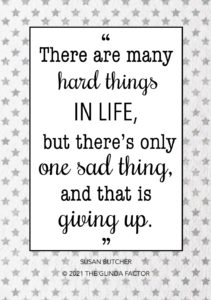 When Susan was 15 years old, she went to New Hampshire to watch a dog sled race. And she was intrigued. After Cabee died, Susan’s aunt gave her a husky (which was the breed most used in dog sled races). Then, Susan got another husky. And she never looked back.
When Susan was 15 years old, she went to New Hampshire to watch a dog sled race. And she was intrigued. After Cabee died, Susan’s aunt gave her a husky (which was the breed most used in dog sled races). Then, Susan got another husky. And she never looked back.
After high school, Susan and her dogs moved to Colorado (where her father lived). While there, she met a woman who bred and trained sled dogs. Susan helped to care for about 50 dogs, in exchange for rooms and board. Susan also took veterinary classes at Colorado State University. Then, she felt Alaska and the Iditarod calling.
When she was 19 years old, Susan moved to Fairbanks, Alaska. Eventually, however, she wanted something more remote. She bought 5 acres of land near Eureka, Alaska — an isolated town 100 miles below the Arctic Circle (140 miles north of Fairbanks). She lived in a log home on the property, which had no running water or electricity. She was miles away from the nearest neighbor. And loved it.
Susan quickly grew serious about breeding and training her dogs for sled racing. She established Trail Blazer Kennels and grew it to over 100 Alaskan huskies. She personally cared for all her dogs on a full time basis — she treated minor injuries and illnesses; she gave them vaccinations; she raised the litters of puppies; and she knew every one of their names. N fact, Susan’s special relationship with her dogs provided a solid foundation for her success in dog sled racing.
Glinda’s Gallery
Just the Facts
- Susan was born on December 26, 1954 and grew up in Cambridge, Massachusetts. She had a sister, Kate (her brother, Evan, died of leukemia before she was born).
- School was tough for Susan — she excelled in science and math but struggled in language arts. Finally, she was diagnosed with dyslexia.
- Susan was a natural athlete and was on the softball, field hockey, and basketball teams in high school. Susan enjoyed sailing every summer in Maine.
- Susan married David Monson in 1985 (he was a fellow musher and became her business manager). They had two daughters, Tekla and Chisana.
- Susan had an impressive record over the course of her 20-year dog sled career:
- She was was the first woman to lead a dog team up Mount McKinley in 1979
- In her first Iditarod in 1978, she placed 19th and won $600 — the first woman to earn any race money
- Susan competed in 17 Iditarod races and placed within the top 10 in all but 2 races.
- She was the first woman to win the Iditarod 4 times — 1986, 1987, 1988, and 1990 (and the first person to win it 3 times in a row)
- She held the Iditarod speed record for 7 years straight
- Susan also earned a number of awards over her career:
- Women’s Sport Foundation’s Professional Sportswoman of the Year award in both 1987 and 1990
- U.S. Victor Award for Female Athlete of the Year 2 years in a row
- Named as one of the “100 Greatest Female Athletes” by Sports Illustrated
- Inducted as a member of the American Academy of Achievement in 1988
- Inducted into the Alaska Sports Hall of Fame
- Inducted into Alaska Women’s Hall of Fame
- Susan was diagnosed with leukemia in 2005. She died in Seattle, Washington, one year later at age 51 (on August 5, 2006).
- The first Saturday of March is Susan Butcher Day in Alaska.
Want to Know More?
Crimson, Ruth. Racing the Iditarod Trail. New York: Dillon Press, 1993.
Dolan, Ellen. Susan Butcher and the Iditarod Trail. New York: Walker and Company, 1993.
Littlefield, Bill and Bernie Fuchs. Champions: Stories of Ten Remarkable Athletes. Boston: Little Brown, 1993.
Wadsworth, Ginger. Susan Butcher, Sled Dog Racer. Minneapolis: Lerner Publications Company, 1994.
Granite & Susan Butcher – Hero & Heroine. Iditarod website (2012 blog posting by Sanka W. Dog).
